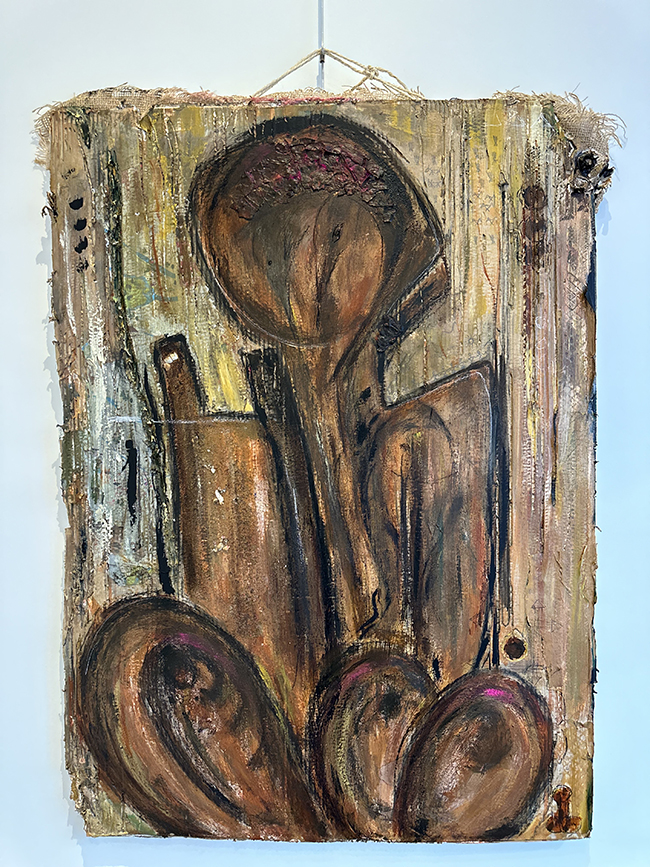VP Vasuhan is a Sri Lankan artist whose journey through life, from his early years in Jaffna to his artistic explorations in Paris, has shaped his unique style and perspective. Born in 1977 in the village of Alaveddy, Jaffna, Vasuhan was surrounded by traditional arts from a young age. His grandfather, an agriculturist, and the local culture deeply influenced him, exposing him to religious paintings, embroidery, pottery, and kolam designs.

His education at Mahajana College, Thellippalai, further nurtured his artistic talents, and upon moving to Colombo in the 1990s due to the ethnic conflict, Vasuhan’s artistic horizons expanded. He explored the local art scene, discovering frescoes, batik, and developing his skills in watercolor. In 1996, he moved to Cyprus to study hotel management but found his true calling in art under the mentorship of Glyn Hughes, a Welsh painter and art critic. This period marked a significant shift in Vasuhan’s artistic journey as he delved into portraiture and figurative painting, organizing exhibitions and immersing himself in the Mediterranean culture.

Arriving in France in 2001, Vasuhan faced challenges as a refugee but persisted in his artistic pursuits. His first solo exhibition, “No Name, No Face,” in 2004, marked a turning point in his career. He continued to exhibit in France and studied documentary filmmaking, reflecting his deep connection to his homeland and the struggles of his people.
VP Vasuhan’s work, Vill – Age, delves into his deep-rooted connection to village life and his reflections on humanity’s bond with nature. The concept is a poetic representation of a world where people coexist with animals, plants, and the natural elements. In this work, Vasuhan merges ancient village life with themes of nature, reflecting his personal memories and experiences of growing up in a small, agrarian community. The village is not just a setting; it becomes the heart of human existence, free from the complexities of modern civilization.

Through Vill – Age, Vasuhan explores a period that exists somewhere between rock art and the emergence of language, where communication happens through sounds, much like the way animals, birds, and other creatures interact. It’s a place where human instincts are closely tied to nature. He imagines a time when humans closely followed animals, observing and emulating their behavior. This primal way of living forms the backdrop for his paintings and other artistic expressions. His depictions of villagers—children, women, men, and elders—reflect a universal village scene, one that draws from diverse global traditions like Kolam, Warli paintings, and rock art.
While Vill – Age is primarily expressed through paintings, Vasuhan’s work also includes sculptures, performances, and installations. These varied forms are meant to represent life lived in harmony with the five elements—earth, water, fire, air, and space—free from the ravages of war or conflict. This vision of life is one that seeks to return to the simplicity of reading and understanding nature, a philosophy of coexistence with the environment rather than domination over it.
Vasuhan uses an array of mediums to bring this vision to life. Natural colors, raw materials, ink, watercolor, acrylic, and pigments blend together on paper, cardboard, wood panels, canvas, and more. This versatility reflects the artist’s commitment to drawing on his surroundings, both physically and emotionally. His memories of growing up in a village surrounded by fertile soil, rain-fed rivers, insects, birds, and animals play a central role in his artistic expression. These memories remain vivid despite his displacement during the Sri Lankan civil war and his subsequent life in urban environments across the world.
This bond to nature was reignited during Vasuhan’s visits to places like Martinique, Guadeloupe, and Japan. He describes how the rice fields of Kagoshima and the village guardian deities he encountered during an art event in Japan reminded him of his homeland. The rural landscapes of these distant places rekindled his memories of Jaffna and village life, reaffirming his connection to nature and the themes that shape his work.
In Vill – Age, the influence of Impressionist painters such as Monet and Van Gogh is evident, but there’s also a strong connection to Sri Lankan art traditions. The landscapes of Vasuhan’s early work were shaped by art history books and the poems of Tamil writers, reminding him of the natural rhythms of village life. He blends these influences with his own lived experiences, creating works that reflect the beauty and simplicity of rural existence.
Vill – Age is more than just a nostalgic reflection of village life; it is also a commentary on modernity’s detachment from nature. Vasuhan questions whether modern civilization, with its rapid technological progress, is in fact pulling us further away from the very elements that sustain us. His art asks us to consider if we are, in a sense, devouring nature in our quest for advancement.
At its core, Vill – Age is an invitation to feel nature once again. Vasuhan encourages his audience to reconnect with the natural world and embrace the harmony that village life offers. His message is clear: the closer we are to nature, the more we understand ourselves and our place in the world. In his eyes, village traditions are not a step backward but a reminder of the life we can live in balance with the earth.


